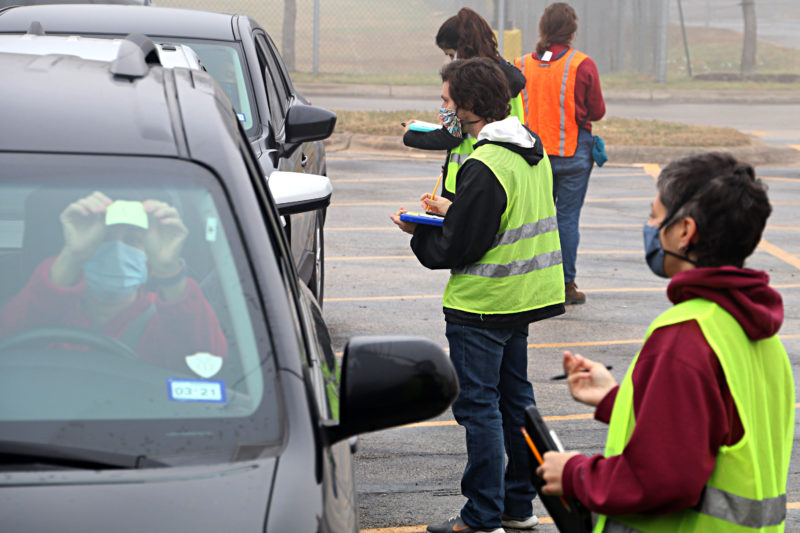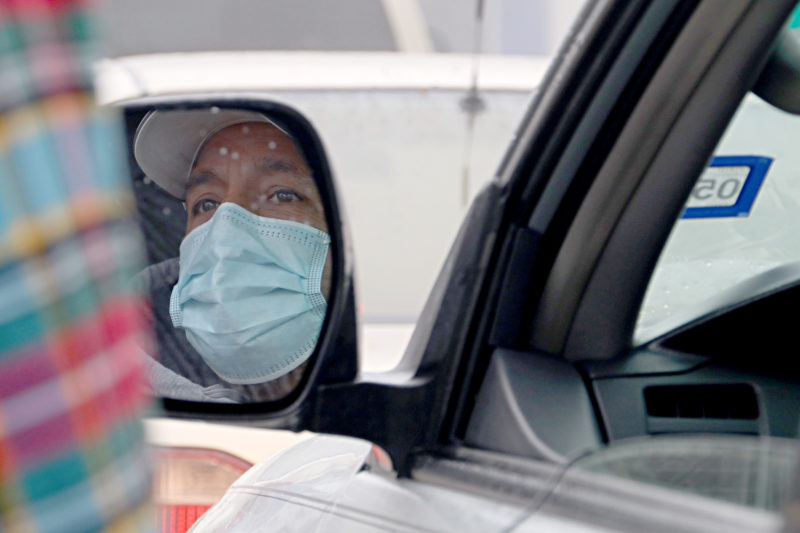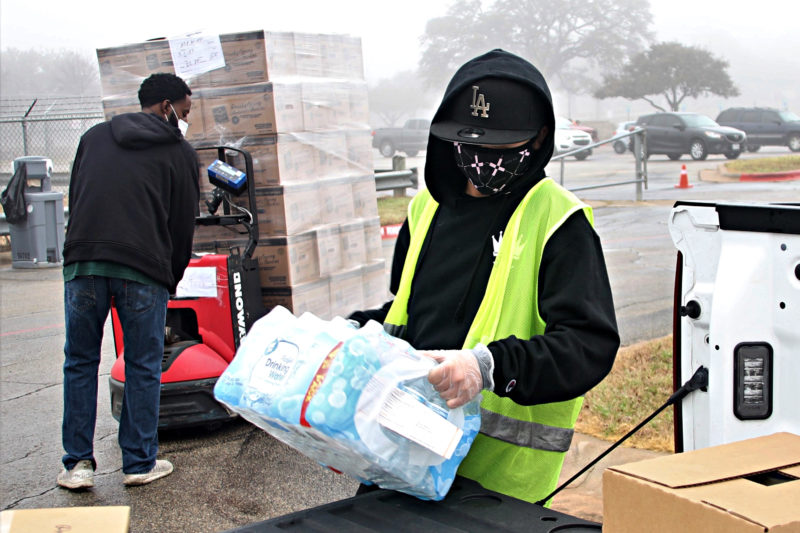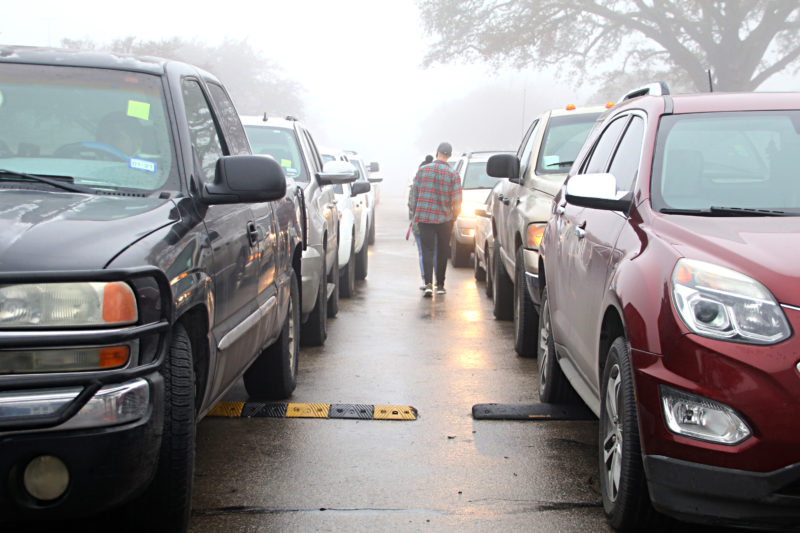Central Texas Food Bank A Godsend for Residents During Pandemic
By Jillian Price
Reporting Texas

Central Texas Food Bank volunteers register clients for the food distribution conducted at KIPP Austin Public Schools-South Campus in Austin, Texas, on Feb. 27, 2021. The Central Texas Food Bank planned to accommodate 1,000 clients whose food insecurity has been an increasing issue due to the ongoing pandemic. Joel Pereira/Reporting Texas
Food banks around Texas are seeing skyrocketing demand.
Prior to COVID-19, the Central Texas Food Bank in Austin served about 237,000 people a month. In January, the Central Texas Food Bank served more than 364,000 people and distributed 4.9 million pounds of food, according to food bank staff.
Food insecurity is a complex issue that has been a major problem in Central Texas since the start of the pandemic, said Cara Allen, a Baylor University doctoral candidate who studies the issue. The U.S. Department of Agriculture defines food insecurity as “a lack of consistent access to enough food for an active, healthy life.”
“Our food banks have been really instrumental in serving our households throughout COVID,” Allen said.
In Texas, one in four households is facing hunger, a number that has nearly doubled since the start of the pandemic, according to a report from the nonprofit organization Feeding Texas. In the first six months of the pandemic, about 400,000 families visited food banks each week in Texas, according to the report. About half of these families were visiting for the first time, the report stated.
During a series of interviews in January and February, customers of the Central Texas Food Bank spoke to Reporting Texas about making ends meet during a singularly difficult time.

Constantino Palma talks about food insecurity due to winter storm Uri as he waits in line at a Central Texas Food Bank distribution at KIPP Austin Public Schools-South Campus in Austin, Texas, on Feb. 27, 2021. Palma, who works in construction and has four children, said that it was his second time at a Central Texas Food Bank distribution event. Joel Pereira/Reporting Texas
Constantino Palma, 49, visited the food bank with his family of five in February. It was the second time Palma has used the food bank since the pandemic started. Palma works in construction.
“I’ve had less work because we have been taking care of ourselves and not being with a lot of people,” Palma said in Spanish.
Palma has focused on taking jobs where he gets to work alone, he said.
“When there’s a job that we can do alone, that’s when we go in to work with more peace so that we can avoid the risks of infecting each other,” Palma said.
Less work has led to less income, and Palma is grateful for the access to food at the food bank, he said.
Destiny Uwa, 51, has been visiting the food bank since November. Uwa lost one of her jobs due to the pandemic, all while her electricity bill was rising.
“Everything is increasing. It makes it very difficult to, you know, to adjust to the situation right now at hand,” Uwa said.
Uwa has three sons, all of whom were at home more often during the pandemic. The family went through food more quickly, as other families experienced, too. Visiting the food bank has helped them tremendously.
“It’s really helping out. It has helped me a lot,” Uwa said.
Ana Torres, 19, is an employee at the clothing store Forever 21. Torres and her husband, who works in construction, have been struggling to take care of their kids, ages 2 and 1, because of lost hours at work, she said. Torres has visited the food bank several times during the last few months.
The winter storm that left millions without power and water for days was also a challenge for the Torres family. They were without water for three days.
“We had to go hunting for food. But good thing because whenever we’re able to come [to the food bank] we stored food,” Torres said.
Torres was able to use some non-perishable food that she had gotten from the food bank during the storm. In addition to fruits and vegetables, the food bank distributes non-perishable items such as canned goods.

Central Texas Food Bank volunteers load food and water in clients’ cars at a distribution conducted at KIPP Austin Public Schools-South Campus in Austin, Texas, on Feb. 27, 2021. Joel Pereira/Reporting Texas
Rachel Carbajal, 69, visited the food bank for the first time in February, she said. Carbajal, who is a dialysis patient, was not working before the pandemic began, but was able to get by without using the food bank. She waited as long as she could to get help.
The winter storm changed things.
“You know, it just like sets you back a bit. So this, with the food bank, with their help, they have no idea [how much they’re helping],” Carbajal said.
Carbajal and her family tried to find food during the winter storm, but there was none in the stores.
“We were trying to look for rice, we were trying to find beans. We couldn’t find any beans,” Carbajal added.
Carbajal said she would use the extra money from not having to buy groceries to buy other important things, such as gas, she said. She is not surprised that so many people need help right now, she added.
“There’s nice cars and nice trucks here. But that doesn’t matter, you know, we need food,” Carbajal said.
Most families who are visiting the food bank are ready for the pandemic to be over, they said. The need for assistance, nationally and around Texas will increase as the pandemic continues, experts say.
“Everyday I pray to God that this COVID ends, you know, that it goes away,” Carbajal said.

Clients wait as they get ready to register for the food distribution hosted by The Central Texas Food Bank at KIPP Austin Public Schools-South Campus in Austin, Texas, on Feb. 27, 2021. Joel Pereira/Reporting Texas